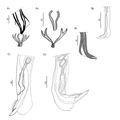Category:Media from Serrano et al. - 10.1051/parasite/2021077
Authors: Paula Carolina Serrano, María Celina Digiani, María de los Angeles Gómez-Muñoz, Juliana Notarnicola, María del Rosario Robles and Graciela Teresa Navone
- (2021). "Hassalstrongylus dollfusi (Nematoda, Heligmonellidae): rediscovery in native South American rodents, six decades after its description". Parasite 28: 80. DOI:10.1051/parasite/2021077.
| Upload media | |||||
| |||||
Abstract
Hassalstrongylus dollfusi (Díaz-Ungría, 1963) Durette-Desset, 1971 was described in a wild house mouse, Mus musculus, from Venezuela and, since then, has never been reported again in the type host or in any other host. In this work, specimens assignable to H. dollfusi were found at 10 localities in Northeast Argentina, in five species of sigmodontine rodents. The nematodes were attributed to H. dollfusi based on diagnostic characters such as: synlophe with 22–31 subequal ridges; in males, hypertrophy of right ray 4 of the male bursa, thickening of the dorsal ray and bases of rays 8, distal tip of the spicules bent and spoon shaped; and, in females, presence of subventral postvulvar alae supported by hypertrophied struts. The new host recorded are: Oligoryzomys fornesi, O. flavescens, O. nigripes, Holochilus chacarius and Akodon azarae. The parasite showed a strong preference for host species of Oligoryzomys, which appear to act as primary hosts. The parasite could be present, parasitizing different species of Oligoryzomys, in a geographic area from the type locality in Venezuela southward to north Corrientes in Argentina. It has not been reported from populations of Oligoryzomys spp. of the Argentinean and Brazilian Atlantic Forest, nor south of 28° S, which may be explained by constraints in the environmental conditions required by the free-living stages of the parasite. This study provides the first identification and redescription of H. dollfusi in southern South America, from autochthonous hosts, six decades after its description.
Media in category "Media from Serrano et al. - 10.1051/parasite/2021077"
The following 6 files are in this category, out of 6 total.
-
Parasite210069-fig1 - Hassalstrongylus dollfusi (Nematoda, Heligmonellidae).tif 2,102 × 2,102; 1.16 MB
-
Parasite210069-fig2 - Hassalstrongylus dollfusi (Nematoda, Heligmonellidae).png 8,400 × 8,400; 7.53 MB
-
Parasite210069-fig3 - Hassalstrongylus dollfusi (Nematoda, Heligmonellidae).png 8,411 × 8,411; 6.28 MB
-
Parasite210069-fig4 - Hassalstrongylus dollfusi (Nematoda, Heligmonellidae).png 8,410 × 8,411; 5.84 MB
-
Parasite210069-fig5 - Hassalstrongylus dollfusi (Nematoda, Heligmonellidae).tif 8,142 × 2,448; 1.5 MB
-
Parasite210069-fig6 - Hassalstrongylus dollfusi (Nematoda, Heligmonellidae).png 8,410 × 3,595; 1.98 MB




